The Dominican Republic, which occupies the eastern part of the island of Haiti and several small nearby islands, is considered among the tourists the best Caribbean destination for beach holidays. Developed upscale infrastructure, marvelous snow-white beaches, amazing beauty of wild tropical nature, architectural sights of the Dominican Republic from the era of Spanish domination – all these elements combine to elevate this country’s status as a premier tourist destination.
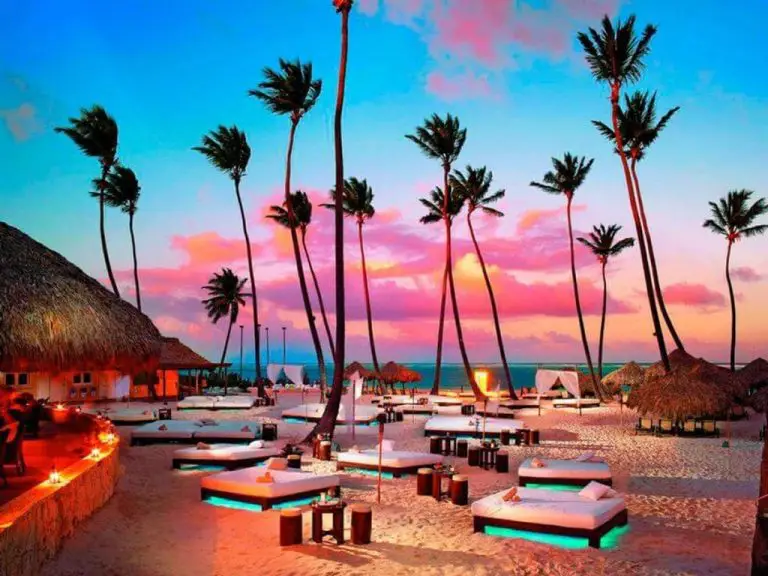
This page contains a selection of the most interesting and noteworthy sights of the Dominican Republic with photos and descriptions. This material will certainly be useful to tourists who want to independently see the most significant and beautiful places of the Republic.
Things to do in Dominican Republic
1. Beaches in Dominican Republic
The main attraction of the Dominican Republic are 1,500 km of white beaches on the shores of the Caribbean Sea and the Atlantic Ocean. The distinctive features of the beaches of the Dominican Republic are powdery white sand, the clean coastal areas, well-developed infrastructure, beach recreation such as diving and jet skiing, and relatively few tourists.
There are so many excellent beaches here that everyone will find something suitable for their tastes.
- The real attraction of the Samana Peninsula is Bonita Beach – the longest in this country, its length is 12 km.
- The area of La Romana is popular among tourists. For example, the recreation area of the Casa de Campo 5 * resort and the village of Bayahibe.
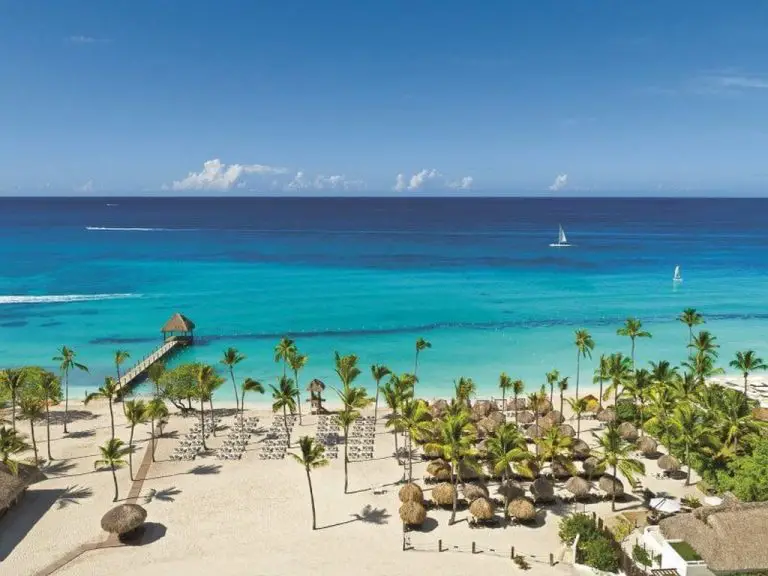
- Located 30 km from Santo Domingo, Boca Chica beach with long shallow water and warm water is ideal for relaxing with children during the day, and at night it turns into a territory for a large “foam party”.
- Many tourists prefer the bustling Bavaro with its fashionable all-inclusive hotels, expensive restaurants and a very high level of service.
- Punta Cana is a place famous for its many popular beaches. Arena Gorda, Juanillo – every year they are among the best in the world.
- Rincon, located at a distance of 5 km from the resort of Las Galeras, is recognized by many tourist publications as the best wild beach in the world.
- The top ten beaches in the Dominican Republic include Playa Grande in the Cabrera area.
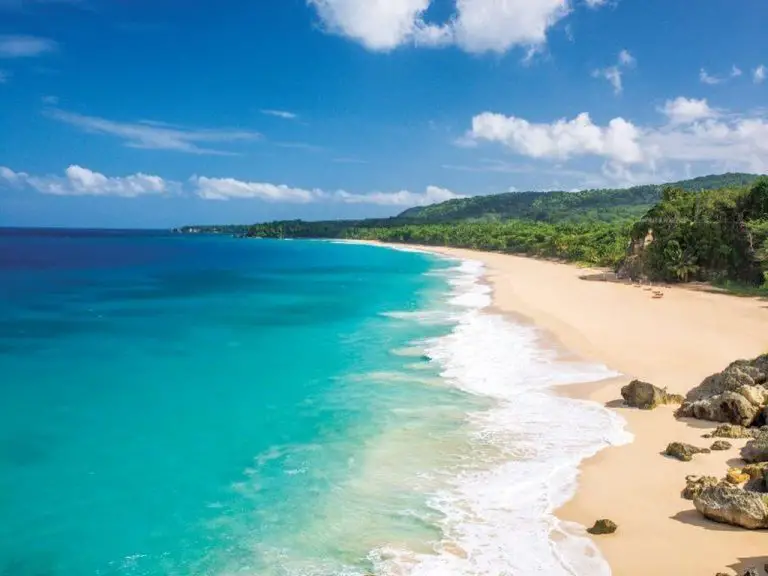
All of the above constitute only a small stretch of the beaches in Dominican Republic. To talk about all the possibilities for a holiday by the sea in this country, you need a separate large article.
2. Visit Saona Island
Since Saona in La Romana province is the largest island in the east of the Dominican Republic, it is not difficult to find this attraction on the map.
Saona Island (110 km²) is part of the Eastern National Park, so construction on its coastline is prohibited, and there are no hotels there. There are only 3 small fishing villages on the island with several hundred inhabitants.
The northwestern part of Saona is considered quite interesting. Here there are caves in which in the 16th century the Taino Indians lived and performed their mysterious rituals. The rest of the island is a series of endless miles of beaches covered with light sand.
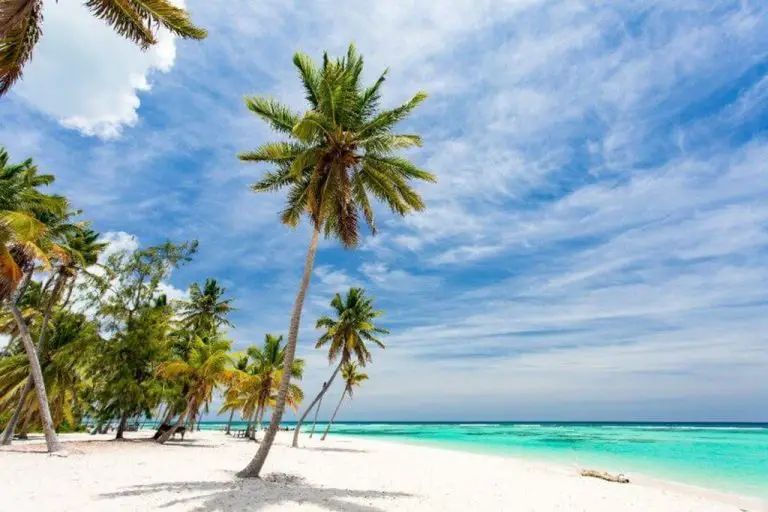
Although the coast is really huge and long, sightseeing trips for tourists are organized on only one beach in this island, where every 20-40 meters is a separate area with its tables and benches, sunbeds and never far from always adequate “ beach amenities”.
The reality versus what can be seen in the photos of Saona Island, also known as Bounty Island, are slightly different. Before you pay $100-150 for an excursion, think carefully about whether you want to head there just to lie on a nice beach, something that you can also do for free in other parts of this country.
But if you go to the island, then you need to look for a travel agency that brings tourists there by 9:00 or after 15:00 to avoid the rush time. The majority of tourists visit this place from 11:00 to 15:00.
3. Scuba Diving and Snorkeling in Catalina Island
Isla Catalina is located on the southeast coast of the Dominican Republic, at a distance of 2 kilometers from the city of La Romana.
A tiny island with an area of just over 9 km², it is completely uninhabited. It is a nature reserve and is protected by the authorities of the Dominican Republic.
On the western side of the island there are white sand beaches that attract fans of eco-tourism. It is a good place to lie down and sunbathe.
Tourists also go to Catalina for scuba diving, for which there are all the suitable conditions: live coral reefs, an interesting underwater world and clear water with visibility up to 30 meters. In terms of underwater beauty, snorkeling and diving in Catalina is the best in the Dominican Republic.
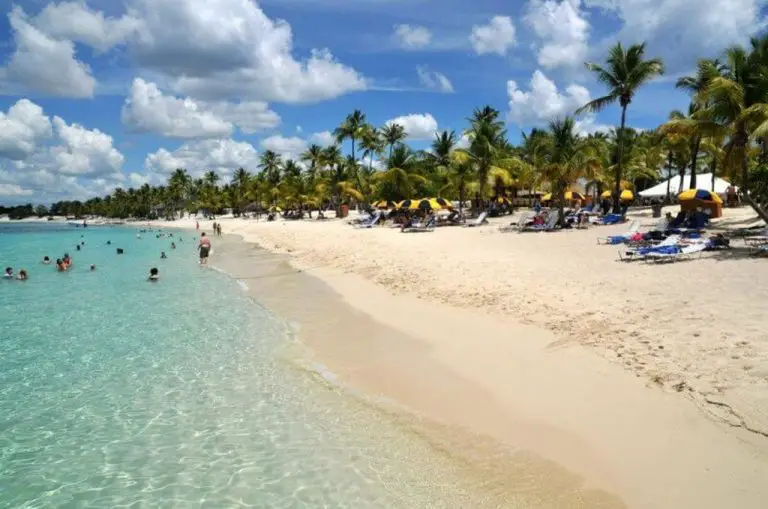
Visiting the island of Catalina is quite simple. Tours are organized from all the popular resorts of this country to this island attraction. Depending on the excursion program and what services are provided, the price can range from $30 to $150.
4. Hike in Isabel de Torres National Park
South of the city of Puerto Plata, on top of the mountain of the same name, is the Isabel de Torres National Park.
This sanctuary houses one of the largest botanical gardens in Dominican Republic. Here you can see thousands of tropical plants: palm trees, fruit trees, ferns, creepers, etc. In the botanical garden there is a pond with turtles and a small cave, as well as a pathway for walks.
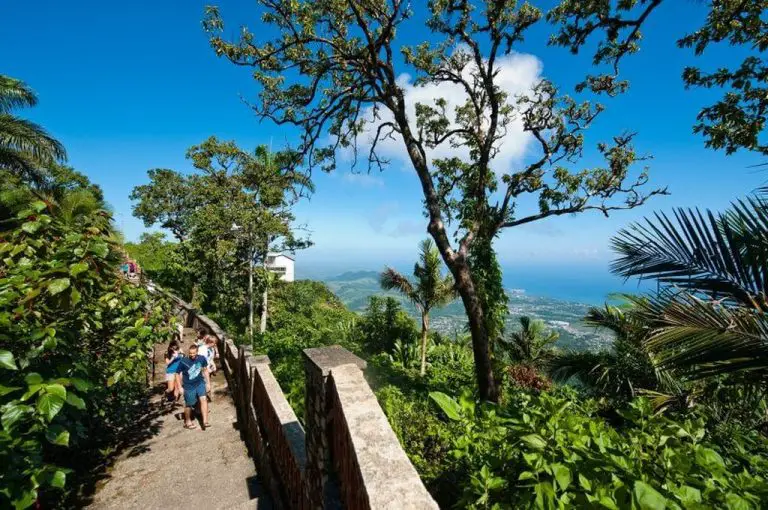
Note that in the Dominican Republic you can see the statue of Christ the Savior which is a small copy of the statue in Rio de Janeiro. This 16-meter-high statue is set on top of the Isabel de Torres mountain.
But the main reason why many climb Isabelle de Torres is the breathtaking views from its top. From a height of 793 meters you can see many places: the Atlantic Ocean and its coast, the whole of Puerto Plata, and even the neighboring regions of Cabarete and Sosua.
Most tour companies include a visit to this national park during a tour of Puerto Plata. You can reserve a spot in such excursion in city hotels for about $55. But you can also visit this place on your own. This way the walk will turn out to be more calm and interesting (there are signs everywhere), and much less expensive.
If you prefer a guided tour, you can simply invite an English-speaking guide to show you around. The service will cost $15-20.
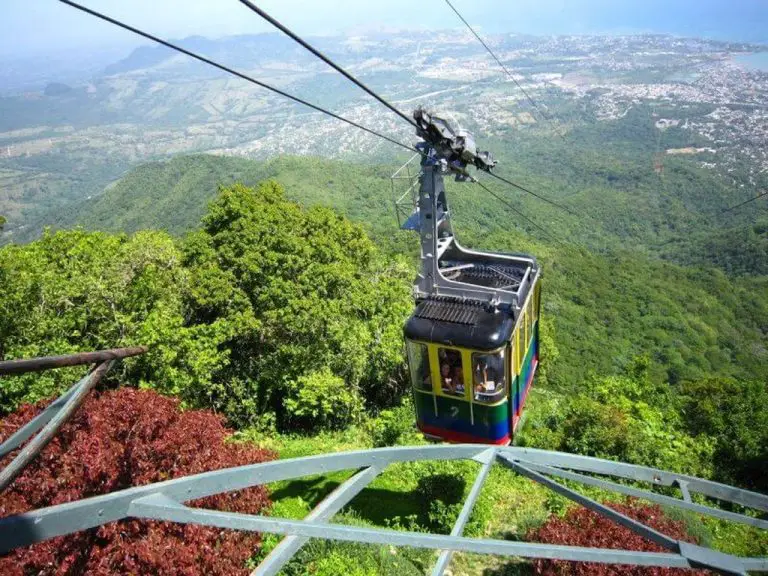
You can climb the mountain along the serpentine road in a rented jeep or bike, or take a taxi. But a more convenient, and more interesting option is to use the only Teleferico Puerto Plata Cable Car, or as the locals say, Teleferico.
Ascent takes about 10 minutes, and during this time you can also see many interesting places from a height if the weather allows. But, as a rule, you will first have to stand in line for 20-30 minutes. First, to buy the tickets (you cannot buy via the Internet), and then in line to get to the funicular itself.
A cable car is open daily from 8:30 to 17:00, and the last trip is 15 minutes before closing.
Teleferico Cable-car fee:
- for children under 4 years old – free of charge
- for children 5-10 years old – $5
- for visitors over 11 years old – $10
Location of the funicular station: Manolo Tavárez Justo, Las Flores, Puerto Plata, Dominican Republic.
5. See the Three Eyes lakes
On the eastern outskirts of Santo Domingo, in the Mirador del Este park, there is a cave complex with 3 lakes known as Los Tres Ojos. This amazing place is one of those that is really worth seeing in the Dominican Republic.
Centuries ago, as a result of an earthquake, cup-shaped faults formed in this place, and after a while, water accumulated from an underground river in them. So there were caves with three underground lakes – they were called Los Tres Ojos, which means “Three Eyes.” Due to the different depths and different chemical composition of the water, water bodies have a different color:
- Lago de Azufre is filled with clear water of a saturated aquamarine hue
- in the small Lago La Nevera, the water is greenish yellow
- El Lago de las Damas occupies a central place in a huge cave with stalactites, the water is quite dark here
The caves are connected by stone steps carved into the rock, there are 346 in total. So see all the lakes, the back an forth trip will be a total of 692 steps. In order to better see all the reservoirs, each of them has a specially equipped place for this.
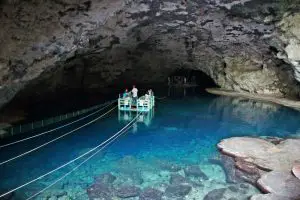
In 1916, the fourth, deepest lake of Lago Los Zaramagullones was discovered. Los Zaramagullones is not included in the Three Eyes complex, but it is the most unusual. Due to the presence of sulfur, the water has acquired a bright yellow color, but it is absolutely transparent – you can even see fish swimming in it. The cave in which this reservoir is located has a ruined arch and is more reminiscent of a volcanic crater, the slopes of which are covered with lush tropical vegetation.
You can get to Lago Los Zaramagullones only on a small ferry, which is pulled through Lago La Nevera. The crossing takes place in an interesting setting – in the dark, under the vaults of the cave, a scene straight out of Harry Potter.
The Three Eyes national park is open from 9:00 to 17:00.
Many travel agencies include visits to this place on excursions around Santo Domingo, but it is better to visit here on your own. You can see the Los Tres Ojos complex for only $4, another 50 cents must be paid for crossing the raft to the fourth lake.
6. Blue Hole Lake
Hoyo Azul is a unique attraction in the Dominican Republic. The lake is rightfully considered one of the most beautiful natural pools on our planet, it is a cenote, that is, a lake in a naturally formed pit.
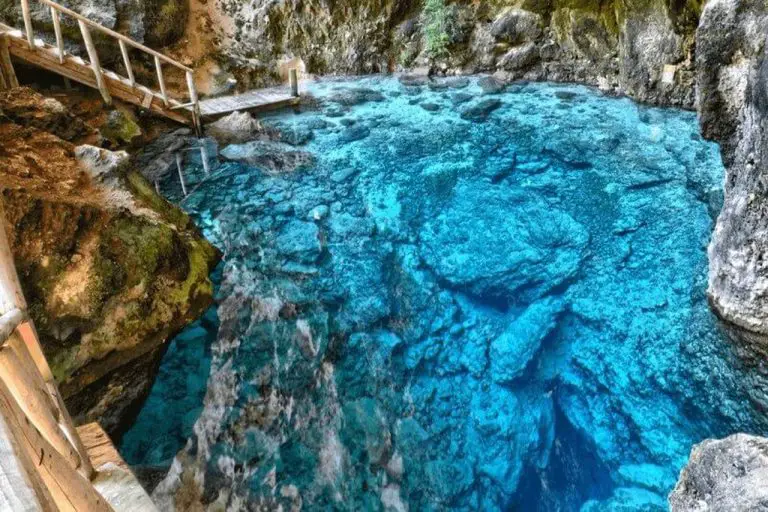
Part of the path to the Blue Hole will take you through virgin rainforests as you climb to the top of Mount El Faraglion. This path in itself is very adventurous, and the journey to the blue hole invariably arouses enthusiastic feelings among tourists.
The water is a stunning blue and unrealistically clean. You can swim, dive from the side if deep enough, and also take beautiful pictures.
Hoyo Azul is located in the southern part of the beach area of Punta Cana, near the city of Cap Cana. You can go to the lake on your own by renting a car, or on a tour with a travel agency.
7. El Limon Waterfall
Tourists are recommended not only to go see the El Limon waterfall, but also to swim in its waters. It is believed that this will bring happiness, luck and prosperity.
You need to go to El Limon in December, when the volume of water falling down is the highest. It falls from a height of 55 meters, and creating wonderful misty scenes. The water in the lake under the waterfall is pretty cold, but it’s nice to swim in.
There are large sharp rocks at the bottom, and diving from a cliff is not recommended due to safety concerns. But you can dive under the stream of water falling in the lake to get into a small grotto.
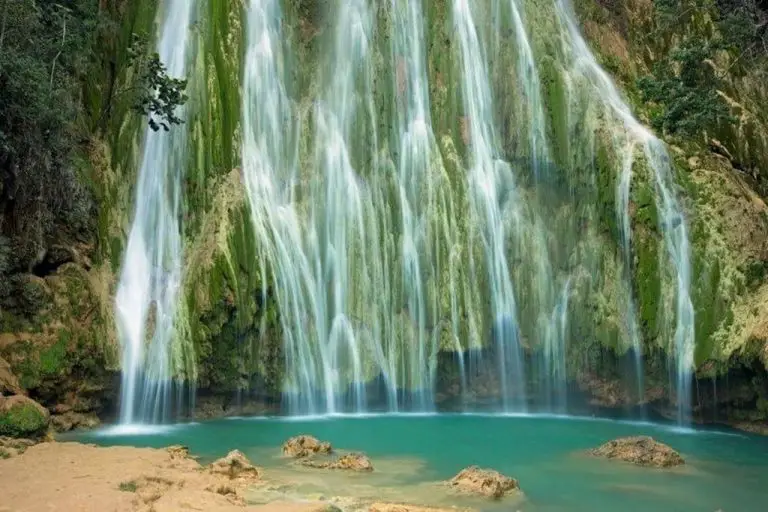
El Limon is located on the Samana Peninsula, surrounded by the tropical jungle of El Limon National Park. The place is very picturesque, but so inaccessible that you can’t get there by car. You will have to walk, and part of the path (the most difficult) can be done on horses, which tourists are offered at several nearby ranches: El Limón, Arroyo Surdido, El Café and Rancho Español. The entire journey from the ranch takes about 1 hour.
Starting points for a trip to El Limon Waterfalls are the cities of Las Terrenas and Santa Barbara de Samana. In these cities, you can go on guided tours, or you can independently get to the ranch along the Bulevar Turistico del Atlantico highway. The tour will cost $150-200. If you drive to the ranch on your own, then you will need to pay about $11 for a horse and a guide, plus about $1 for entrance to the park. Conductors who ride a horse all the way are usually given tips in the amount of $2-15.
8. Cascade of 27 waterfalls or 27 Charcos
Lovers of outdoor activities will really like visiting the “27 Waterfalls”. This place is located in the mountains, very close to the city of Puerto Plata (20 minutes ride), and is a natural water park with multi-level water slides, created by nature itself, or rather, mountain rivers.
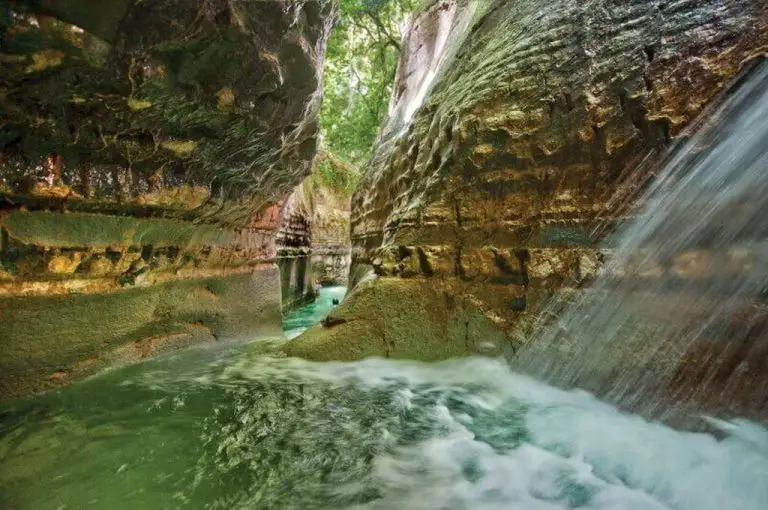
There are 3 difficulty levels which differ in the number of slides (7, 12 and 27) and, accordingly, their height. Of course, jumping from a 1-meter height is not too attractive, but a 6-meter jump is already breathtaking. And not everyone risks jumping from a height of 8 meters.
Those who do not want indulge in such sport can independently go around each waterfall on the wooden steps arranged next to it.
The average price for a tour from a tour operator is $135. It will be cheaper to visit this natural attraction on your own:
- a taxi from Puerto Plata costs about $30
- $10 for admission ticket
- $3 for storing luggage for two
- $2 for rental shoes for jumps, if necessary
For an additional fee of $40 you can hire a photographer. To take photos and videos yourself, you will need waterproof gadgets!
9. City of Artists – Altos de Chavon
City of Artists is one of the most popular tourist attractions of the Dominican Republic. Although the town is quite small (you can get around it in 15 minutes), there is many things to see here.
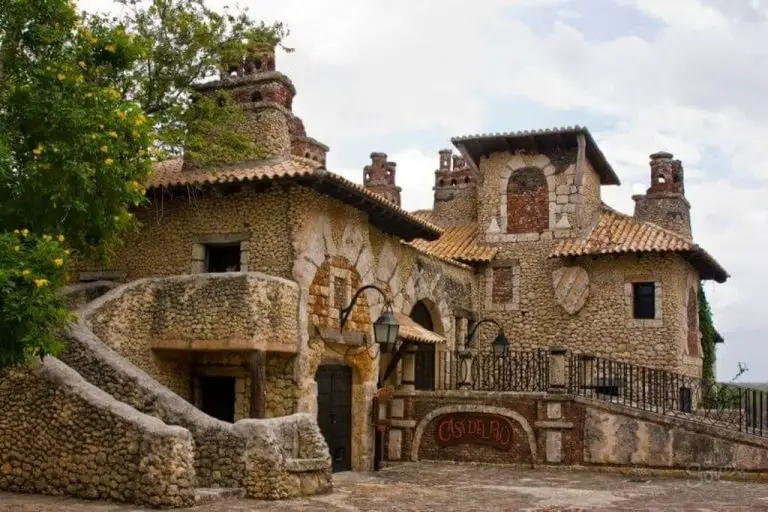
Altos de Chavon is part of the Casa-de-Campo resort in La Romana. Altos-de-Chavon is an exact copy of Spanish villages from 15th-16th centuries, and it was built not so long ago from 1976 to 1992. All streets are lined with cobblestones and real oil lamps in metal cases hang on stone houses.
In the City of Artists, everything is designed for tourists. There are art salons, jewelry galleries, craft shops, souvenir shops, bars and restaurants. The most interesting places to see in Altos-de-Chavon are:
- St. Stanislaus Church, in which Michael Jackson and Lisa Maria Presley were married
- observation platform with a view of the Chavon River
- Amphitheater for 5,000 spectators, where many “stars” performed in concerts
- a fountain in which it is customary to throw coins, while making a wish
There are several museums in Altos de Chavon, the most interesting is the Archaeological Museum, which presents items from the pre-Columbian era that tell about the life of the Taino Indians.
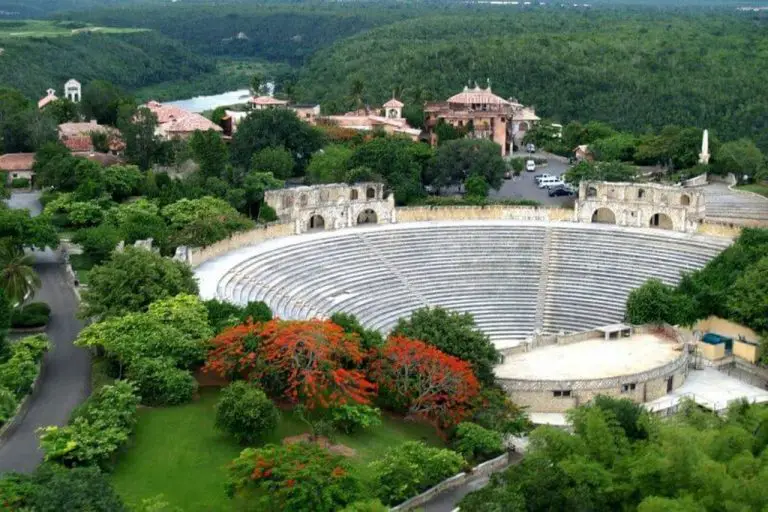
You can visit Altos de Chavon on your own or buying an entrance ticket for $25. You can also see this attraction during guided tours, for example, to the islands of Saona or Catalina.
10. Colonial Zone in Santo Domingo
The historical city of Santo Domingo in the sixteenth century served as the first European settlement in the New World. This place allows tourists to experience the true, very interesting and peculiar flavor of Santo Domingo.
Zona Colonial is located on the Caribbean Sea and on the west bank of the Osama River. In this area of about 5 km² the largest number of historical attractions of the Dominican capital is concentrated. There are beautiful old buildings, churches, architectural monuments and famous streets.
The center of the Colonial Zone is Park Colon or Columbus Square. The highlight here is the monument to the great navigator Christopher Colombus. Other local attractions include the oldest Osama fortress in the New World, in which Christopher Columbus lived for 2 years. On the eastern side of the old district is Calle Las Las Damas, the oldest in the New World, paved with cobblestones.
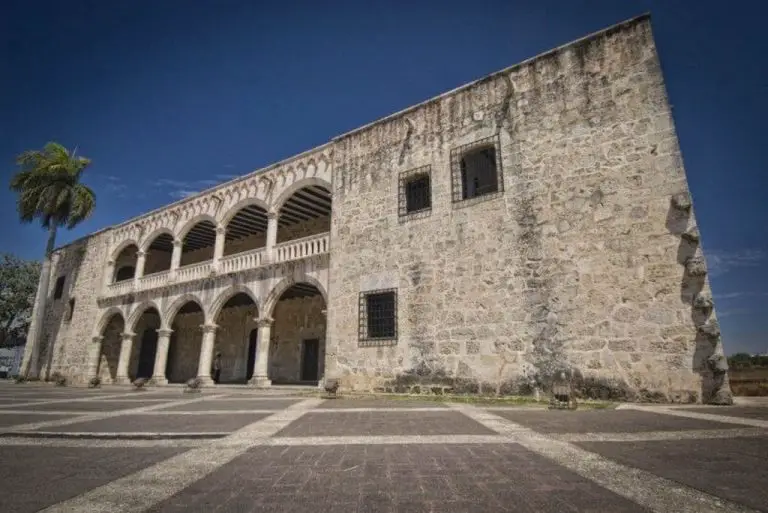
The old city also houses interesting museums, mainly adjacent to Columbus Square.
You can visit the Colonial Zone in Santo Domingo with a guided tour – they are organized in almost every travel agency. But many tourists recommend ditching the guied tours to seeing Zona Colonial on your own. Of course, it is advisable to read the guidebooks first, so that you can enjoy your trip without haste.
Walking around the Old Town on your own is also much cheaper than with a guided tour. The price of tickets to state museums is low ($1.90-4.75), and some are free such as Casa de Duarte and Panteon de la Patria. To see the collections of private museums, you will have to pay a little more ($5.70-13.30). In all museums, visitors are provided with audio guides in various launguages.
If you don’t feel like walking around the Colonial Zone yourself, you can contact the service of state guides (all guides speak English). The cost of an private tour must be discussed personally and in advance, but it is quite possible to keep it at $40-50.
Cathedral of Santo Domingo
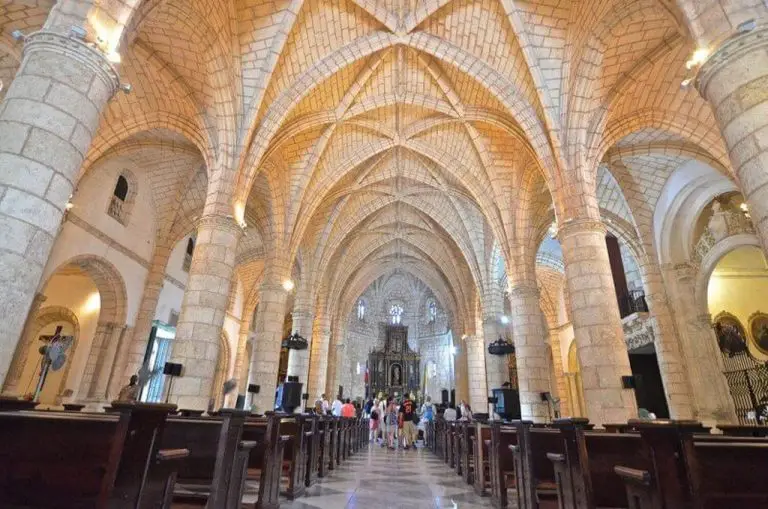
The Cathedral of Santa María la Menor is not just an interesting architectural landmark, but the main active Catholic cathedral of the city of Santo Domingo, the capital of the Dominican Republic. It is not at all difficult its location in the historical part of the city, Isabel La Catholica Street.
The cathedral built in 1546 is designed in the Gothic style. You can see the temple not only from the outside, but also inside. There are many works of art such as monuments, sculptures, altars, chandeliers and paintings that are preserved since the colonial era.
For some time the remains of Christopher Columbus were also stored here.
Entrance to the Cathedral of Santo Domingo is free and at the entrance tourists are offered headphones and an audio guide. You can visit the cathedral and see its interior on any day from 9:00 to 16:30.
The prices and schedules in the article are relevant for October 2019.
Summary
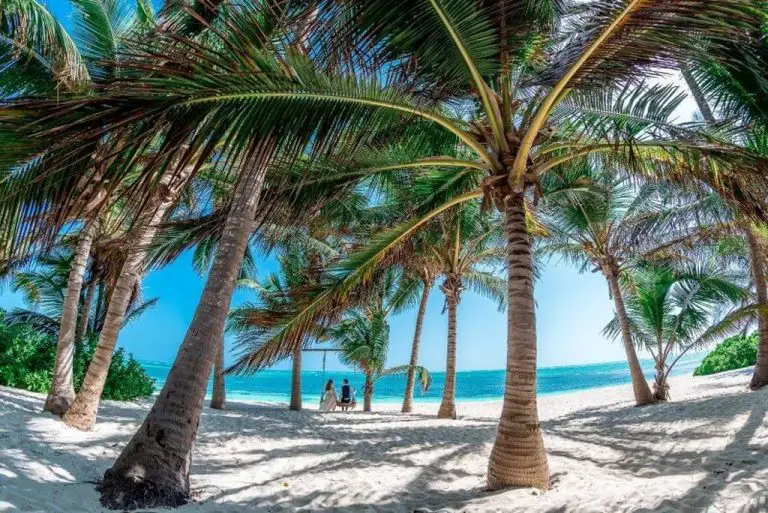
Here is a recap of the best things to do in Dominican Republic:
- Beaches in Dominican Republic
- Visit Saona Island
- Scuba Diving and Snorkeling in Catalina Island
- Hike in Isabel de Torres National Park
- See the Three Eyes lakes
- Blue Hole Lake
- El Limon Waterfall
- Cascade of 27 waterfalls or 27 Charcos
- City of Artists – Altos de Chavon
- Colonial Zone in Santo Domingo